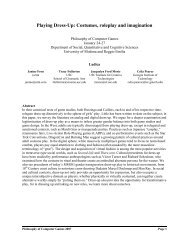The Irreducible Self: Image Studies of First Person
The Irreducible Self: Image Studies of First Person
The Irreducible Self: Image Studies of First Person
Create successful ePaper yourself
Turn your PDF publications into a flip-book with our unique Google optimized e-Paper software.
Conference-Paper: „<strong>The</strong> Philosophy <strong>of</strong> Computer Games“, Reggio Emilia, 25-27 Jan. 2007Dr. Stephan Günzel (Friedrich-Schiller-University Jena)<strong>The</strong> <strong>Irreducible</strong> <strong>Self</strong>: <strong>Image</strong> <strong>Studies</strong> <strong>of</strong> <strong>First</strong> <strong>Person</strong> Perspective Computer Games1. IntroductionIn this paper I will claim that first person shooter games have to be conceived <strong>of</strong> as artifactsthat, by means <strong>of</strong> visual presentation, provide a pro<strong>of</strong> for the existence <strong>of</strong> the self as astructural relation. In other words, a certain type <strong>of</strong> video game, conceived <strong>of</strong> predominantlyas an image, can function as a argument for a philosophical concept.2. <strong>Image</strong> <strong>Studies</strong>: Games as <strong>Image</strong>sMy thesis assumes that computer games are, first and foremost, pictorial objects, viz. images.As the initial debate on principles within the young branch <strong>of</strong> computer game studies hasshown, there is a contradictory and even aporetical opposition between ludological andnarratological approaches to games (Frasca 2003). To both positions – the narratological aswell as the ludological – a computer game is not categorically different from what alreadyexisted before the age <strong>of</strong> computational technology: a text or a game. Computer gamestherefore are taken as a transformation or transposition <strong>of</strong> something old into a new medium;the text becomes an interactive text and play becomes virtual play.It is striking, as far as I can tell, that no one yet has noted the fact that computer games areimages. – At least no one has noted that this instance is <strong>of</strong> fundamental relevance to the study<strong>of</strong> computer games. Only a related argument has been made on this, stating that computergames are immersive by means <strong>of</strong> their presentational aspect. In her article on Immersion,Engagement, and Presence Alison McMahan (2003), for example, makes an important claim:she points out that one has to distinguish carefully between immersion in a diegetic andimmersion in a non-diegetic sense. In the diegetic sense, “immersion” designates the aspect <strong>of</strong>someone being fascinated by the narration <strong>of</strong> the game or the game play. Different from this,on the non-diegetic level, “immersion” indicates the aspect <strong>of</strong> someone having the feeling <strong>of</strong>what McMahan, with respect to Jonathan Steuer (1992), calls a “being there.” Immersion isthus understood as the illusory impact <strong>of</strong> the medium. (And, I would add, as the illusoryimpact <strong>of</strong> the image.) However, immersion in the non-diegetic sense describes only acontingent and empirical fact <strong>of</strong> someone losing the feeling for the difference between medial
2content and its natural surrounding. <strong>The</strong>refore, immersion actually says nothing about themedium, but rather something about the user. And that means that immersion is not anattribute, which can be applied to the game’s design, but rather to the psychological condition<strong>of</strong> the gamer.Nevertheless McMahan provides a hint as to which aspect <strong>of</strong> the game as a pictorial artifact isa necessary precondition for immersion, namely presence. To McMahan, the feeling <strong>of</strong> “beingthere” is only achieved when the virtual space in which the player immerses is presentedartificially. Presence, however, is a central feature <strong>of</strong> images; what images do is presentobjects that only exist on behalf <strong>of</strong> the image. Just as a record can artificially present sound tothe human ear, pictures artificially present things that are only visible to the human eye. But,as opposed to objects <strong>of</strong> the real world, image-objects can only exist or not exist. <strong>The</strong>y cannotbe absent like a person who is not here at the moment. Objects that are presented to a viewerby a picture are either present or they do not exist. In addition, pictures thus do not showthings that are now absent and present somewhere else in the world, but they add new thingsto the world right here and right now.<strong>The</strong> same is true for computer games; they do not show something that is absent, instead theypresent something that has not existed before without being visualized. Video games present avirtual reality. But different from other types <strong>of</strong> images, computer games <strong>of</strong>fer images, whichhave to be used. In my opinion, we must therefore think <strong>of</strong> video games as something thatmust been seen in order to be played. Without that particular performativity a computer gameis not different from a movie or even a photograph.Furthermore, this means that there exists a significant difference even within computer games;on the one hand, there are games that could also be played without a computer, just on paper,such as strategy games or role-playing games. On the other hand there are games that cannotbe played without an image. But, as opposed to photographs, paintings, or even films,computer game pictures are interactive. <strong>The</strong> mode <strong>of</strong> reception <strong>of</strong> a computer game istherefore not contemplation, but rather interaction. And what the player does when he or sheinteracts is actually an interaction with the image, i.e. with the objects presented by thepicture.My proposal at this point is to address these images formally as “simulation” or simulationpictures. <strong>The</strong>re has been an ongoing debate in computer game studies on whether simulationrefers to a certain type <strong>of</strong> computer game or to something that is not a game at all. Chris
3Crawford (1984), for example, has argued that a simulation is the opposite <strong>of</strong> a game; for him,FLIGHT SIMULATOR, for instance, is not a game, since there is no aim or goal <strong>of</strong> the gameother than learning how to fly. On the contrary, strategy games are sometimes referred to as“simulation games” because they provide tools for anticipating future developments on thebasis <strong>of</strong> empirical values and a working model. – To me, neither <strong>of</strong> the two usages isappropriate; following Crawford, DOOM would not have to be considered a game because theinteractive picture only simulates the use <strong>of</strong> different weapons. Conversely, the second usage<strong>of</strong> the term applies to nothing that is specific to computer games (even though ‘strategygames’ are a designated game genre). Like any other “simulation,” i.e. in the social sciences,a simulation can also be calculated without the aid <strong>of</strong> a computer. – It just takes a little longer.In speaking <strong>of</strong> a “simulation” I would like to address images that are transformed by the user.To put it more strictly, the way a simulation picture is received is the user’s interaction withthe picture. This means that, in contrast to a movie image, a simulation image does notreproduce movement, but rather produces it. So in my opinion, FLIGHT SIMULATOR canrightly be addressed as a computer game. In a theoretical respect, it furthermore can even beconsidered to be a systematic nucleus <strong>of</strong> computer games; what makes computer gamesdifferent from all other artifacts is, in my view, the fact that they present objects that someoneengages with on the basis <strong>of</strong> pure visibility. It would thus be more specific to call thoseartifacts “video games” and not only “computer games.” (Usually this term is applied toarcade games. In the Anglo-Saxon context the term is sometimes used conversely as a meresubstitute for “computer games.”)To me this problem is not a matter <strong>of</strong> theoretical self-sufficiency, but is essential to the waywe approach virtual gaming. Do we think <strong>of</strong> it as something new, or is it just something wealready had before the age <strong>of</strong> computers? To turn the problem into a decent question: Arethere any computer games or video games in which the gaming principle is derived purelyfrom the structure <strong>of</strong> the simulation-image itself? If the response to this question is positive,then we have pro<strong>of</strong> for the conjecture that computer or video games are phenomena suigeneris. In my view those games which prove that computer games have, in fact, broughtabout something new are first person shooters; in a shooter game the interaction is strictlyderived from the formal organization <strong>of</strong> the visual image. (I would even go so far as to arguethat an interactive image, which is designed according to the principle <strong>of</strong> central perspective,can only provoke that particular usage <strong>of</strong> ‘aiming and shooting’. – Any other usage does notderive from that very composition <strong>of</strong> the picture.)
43. Philosophy: Concepts as Games<strong>The</strong> first person has <strong>of</strong>fered a problem to Philosophy since the classical era. Undoubtedly themost prominent theory <strong>of</strong> subjectivity or self-consciousness is the Cartesian concept <strong>of</strong> the rescogitans; Descartes thinks <strong>of</strong> the world as something opposed to the spectator. Even the body<strong>of</strong> the I is only a part <strong>of</strong> the extensional world, which separates it from the mind. That is thereason why in Descartes’ skepticism, the existence <strong>of</strong> the body can be doubtful, but not theexistence <strong>of</strong> the res cogitans. To put this in terms <strong>of</strong> the video game, Descartes’ ontology isthat <strong>of</strong> a classical computer game in which the visible world also appears as a res extensa.One need only recall games like FROGGER or ZAXXON, in which the acting person, animal orvehicle is part <strong>of</strong> the objective world. It is presented as an extended corpus amongst otherobjects that persist within the virtual world. That corpus is what is called an “avatar”. Eventhough the avatar can be steered freely by the player, the figure itself is part <strong>of</strong> the game worldand subordinated to its defined physical conditions. Freedom only exists on the side <strong>of</strong> theplayer and on his or her side <strong>of</strong> the screen. <strong>The</strong> player is situated in the res cogitans, whereasthe avatar is located in the realm <strong>of</strong> the res extensa.In my opinion this is one reason why many video game theorists tend to speak <strong>of</strong> computergames spaces as “representational spaces.” In many games the interaction with the objectsthat appear is based on a representational relation in the Cartesian sense. If you think <strong>of</strong>Descartes’ model <strong>of</strong> vision, which is based on the functionality <strong>of</strong> a cameraobscura (Crary 1990), one can be tempted to believe that the human mind is an entity,separated from the world and looking at its objects on a screen. As in the camera obscura, theviewer is settled inside an apparatus that represents the outside world. To a player <strong>of</strong> aclassical computer games the visual presentation <strong>of</strong> that virtual world appears to be arepresentation <strong>of</strong> it. One does not steer himself or herself, but rather steers an agent <strong>of</strong> the self.In philosophy, such a situation provokes the so-called “homunculus fallacy”: if the mindobserves the world (hence, a representation <strong>of</strong> it) from the inside, who or what is the instanceperceiving what the mind sees?<strong>The</strong> Cartesian concept <strong>of</strong> the self has been heavily criticized throughout modern philosophy.One <strong>of</strong> its critics was Immanuel Kant, who argued that the self is only an idea that allows usto ensure consistency among our perceptions <strong>of</strong> the world. To Kant, it is, however, atranscendental condition (for the subject to be). Reacting to Kant, Ludwig Wittgenstein wrotein the Tractatus: “<strong>The</strong> subject does not belong to the world but it is a limit <strong>of</strong> theworld” (Prop. 5.632). By some interpretations, this quotation – in the light <strong>of</strong> the “linguistic
5turn” – is an argument against the existence <strong>of</strong> the subject. In particular, Margaret Anscombein her essay <strong>The</strong> <strong>First</strong> <strong>Person</strong> has argued that when someone says “I,” he or she does notmake use <strong>of</strong> a proposition that designates anything that exists as an exclusive object in theworld; anybody can say “I.” – Very much in line with Nietzsche she conceives <strong>of</strong> the subjectas a “grammatical illusion” that occurs in the search for the cause <strong>of</strong> a particular“happening” (Anscombe 1975, 64).I for one think that Wittgenstein should be understood in a different way, taken as aproposition, “I” is not, in fact, something that articulates an individuality. But taken assomething that is articulated by a speaker, saying “I” is something exclusive to the personwho speaks. “I” is thus not a proposition, but an expression <strong>of</strong> the first person-status. Itfollows that that relation can no longer be explained within language. If I’m readingWittgenstein correctly, he argued that the I (or the solitary situation) is nothing that we cantruly speak <strong>of</strong>, but rather something that is true because we can see it: “In fact what solipsismmeans is quite correct, only it cannot be said, but it shows itself.” (Prop. 5.62)What Wittgenstein addresses here is the truth <strong>of</strong> the self, revealed to a person being in theworld and, furthermore, also being aware <strong>of</strong> himself or herself as the “border” <strong>of</strong> his or herperspectival view <strong>of</strong> the world. What is interesting in the video game context is the fact that,according to Wittgenstein, the truth <strong>of</strong> solipsism – i.e. that the world is my perspective <strong>of</strong> theworld – cannot be deduced from the linguistic proposition “I,” but rather shows itself. In otherwords, a world that is presented as an exclusive world (solely) to the I. <strong>The</strong> I or the firstperson hereby is conceived <strong>of</strong> as a relational self; the world stands in relation to the subject,and thus the subject is an entity in relation to the world – what Wittgenstein calls the“border.” According to Edmund Husserl’s teacher, Franz Brentano, this very structure can beaddressed by the term “intentionality”: in contrast to Descartes’ model <strong>of</strong> the self as a rescogitans that is separated from the world, the self according to Brentano (1995) is understoodas something that exists only in relation to the world and objects in the world.In a phenomenological backslash to analytic philosophy, Hector-Neri Castaneda and RoderickChisholm in particular drew on Brentano’s idea <strong>of</strong> intentionality. Castaneda (1999) remindsus that I is not a proposition at all, but furthermore a pronoun. As such, I has no reference(Bedeutung), but is an indicator for the situation <strong>of</strong> the first person. And reacting toChisholm (1981), the utterance <strong>of</strong> “I” rests upon the conviction that “I am,” which in turnprovides a matrix for the belief that a proposition can be true.
6Now what a first person shooter game as an image achieves is to show this intentional relation<strong>of</strong> a self to the world and its objects. But it does not only “show” it, as Wittgenstein says, butfurthermore forces the player to make use <strong>of</strong> the picture as if the self existed. This is the keypoint to my argument: I would not say that the I or the self exists in the metaphysical or evenin the biological sense. Presumably no one will ever find a pro<strong>of</strong> for this – but the simulationpicture <strong>of</strong> a first person shooter demands that the user behaves as if his I or self existed. Andthis behavior or interaction with the image-objects presented by the video game derives fromthe perspectival organization <strong>of</strong> the simulation image. <strong>The</strong> main characteristic <strong>of</strong> this image isthe alignment <strong>of</strong> the vanishing point with the junction <strong>of</strong> the crosshairs in the view-finder <strong>of</strong>one’s weapon. It is by virtue <strong>of</strong> this fact that the image presents intentionality.<strong>The</strong> movement in virtual space thus is secondary to this primary interaction: for thepredominant action is when the player has to make an object coincide with the vanishingpoint. Factually, he or she does not move in space, but rather primarily moves space itself. Inthe simulation image the line <strong>of</strong> sight is centralized and fixed, and what is steered by theinterface is the virtual space around it. <strong>The</strong> simulation picture <strong>of</strong> the first person shooter typethus visualizes intentionality and, furthermore, uses it as the major basis for interaction. Andthis interaction derives from the image’s composition alone.4. ConclusionMy argumentation results in two consequences: on the one hand, I have intended to show thatcomputer games must be analyzed as images. Through such an analysis, we may find a thirdway: approaching these artifacts neither as a form <strong>of</strong> narration in a new medium nor as a rulebased in the virtual realm. On the other hand, I hope to have demonstrated how this approach<strong>of</strong>fers a contribution to the philosophy <strong>of</strong> computer games: taken as (interactive) picture,certain video games have the potential to give a pro<strong>of</strong> in the form <strong>of</strong> an image for theexistence <strong>of</strong> a highly disputed philosophical entity, namely the <strong>Self</strong>.
75. ReferencesTextsANSCOMBE, G. E. M. (1975): “<strong>The</strong> <strong>First</strong> <strong>Person</strong>,” in: Mind and Language, ed. by SamuelGuttenplan, Oxford: Clarendon Press, pp. 45-65.BRENTANO, Franz ( 2 1995): Psychology from an Empirical Standpoint, trans. Antos C.Rancurello, Dailey B. Terrell and Linda L. McAlister, ed. Linda L. McAlister,London: Kegan & Paul 1969 [1874].CASTAÑEDA, Hector-Neri (1999): <strong>The</strong> Phenomeno-Logic <strong>of</strong> the I. Essays on <strong>Self</strong>-Consciousness, ed. James G: Hart and Tomis Kapitan, Bloomington: IndianaUniversity Press.CHISHOLM, Roderick, M. (1981): <strong>The</strong> <strong>First</strong> <strong>Person</strong>. An Essay On Reference andIntentionality, Brighton: Harvester.CRARY, Jonathan (1990): Techniques <strong>of</strong> the Observer. On Vision and Modernity in theNineteenths Century, Cambridge/London: MIT Press.CRAWFORD, Chris (1984): <strong>The</strong> Art <strong>of</strong> Computer Game Design. Reflections <strong>of</strong> a Master GameDesigner, Berkeley: Osborne/McGraw-Hill[www.mindsim.com/MindSim/Corporate/artCGD.pdf].FRASCA, Gonzalo (2003): “Simulation versus Narrative. Introduction in Ludology,” in: <strong>The</strong>Video Game <strong>The</strong>ory Reader, ed. Mark J. P. Wolf and Bernard Perron, NewYork/London: Routledge, pp. 231-235.MCMAHAN, Alison (2003): “Immersion, Engagement, and Presence. A Method for Analyzing3-D Video Games,” in: <strong>The</strong> Video Game <strong>The</strong>ory Reader, ed. Mark J. P. Wolf andBernard Perron, New York/London: Routledge, pp. 67-86.STEUER, Jonathan (1992): “Defining Virtual Reality. Dimensions Determining Telepresence,”in: Journal <strong>of</strong> Communication 42(4), pp. 73-93.WITTGENSTEIN, Ludwig (1961): Tractatus-logico philosophicus, transl. Charles K. Odgen andBrian F. McGuinness, London: Routledge [1921].GamesDOOM (1993), developed and published by id S<strong>of</strong>tware, PC.FLIGHT SIMULATOR (1982): developed and published by Micros<strong>of</strong>t, PC.FROGGER (1981): developed by Konami, published by Sega/Gremlin, Arcade.ZAXXON (1982): developed and published. by Sega, Arcade.






